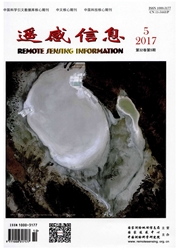

 中文摘要:
中文摘要:
使用多时相遥感数据进行景观变化检测往往要求这些遥感数据能保持辐射一致性,但实际获取遥感数据时由于传感器性能、大阳照度几何和大气状态的变化,多时相遥感数据的辐射一致性无法保持。鉴于多时相遥感数据实际应用时需要实施相对辐射归一化操作,以南京市主城区1992年、1998年、2003年、2007年和2011年5景Landsat TM热红外波段数据为源数据,反算亮温图像并与8个地面气象站采集的实时温度数据建立回归模型,反演地表温度图像,然后采用伪不变特征相对辐射归一化方法和多元变化检测相对辐射归一化方法对5期地表温度数据做归一化处理,分级操作后评价南京市热岛效应的变化特征,最后通过引入统计特征参数均方根误差和变异系数,评价两种相对辐射归一化方法的优劣。结果表明:经过两种归一化方法调整后的数据均有利于对南京市热岛效应的分析;在后续的热岛效应分析中,多元变化检测相对辐射归一化法处理后的影像优于伪不变特征相对辐射归一化处理的影像;多元变化检测归一化法克服了人工选取样本点中存在的主观因素,但其计算相对较复杂。
 英文摘要:
英文摘要:
The detection for the landscape change using remote sensing data often requires the radiation consistency of these data. However, the multi-temporal satellite images cannot keep radiation consistency due to the sensor capability, sun illumination geometry and the change of the atmospheric conditions. Hence,relative radiometric normalization should be done in real application. Taking Nanjing as the case study, using the Landsat TM observations acquired in 1992,1998,2003,2007 and 2011, the surface brightness temperatures of the primary urban areas of Nanjing were derived first, followed by the retrieval and mapping of the true ground temperatures through linear regression models constructed on the basis of the nearly simultaneous temperature data collected from the eight local observatories. Relative radiometric normalization based on the PIFs and the MAD algorithms were applied to normalize the true surface temperature images to eliminate the seasonal and annual variations, which makes all the resulted ground temperature images comparable directly. Furthermore, the spatio-temporal patterns of the heat islands were characterized by implementing the grading operations. The results showed that the two suites of normalized images derived here were more beneficial and accurate to characterize urban heat island effects than the original images. In addition, the multivariate alteration detection algorithm was proved to he superior to the relative radiometric normalization using the pseudo-invariant features when taking the normalization performance into consideration, which can overcome the subjectivity of the PIFs method, but with more complexity of computation.
 同期刊论文项目
同期刊论文项目
 同项目期刊论文
同项目期刊论文
 期刊信息
期刊信息
